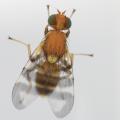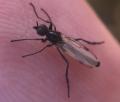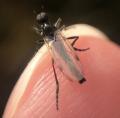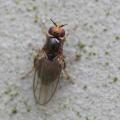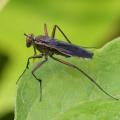Diptera.info :: Identification queries :: Diptera (adults)
Who is here? 1 guest(s)
|
[Lucilia sp] Calliphoridae ?
|
|
| Arthropa |
Posted on 07-09-2004 22:30
|
|
Member Location: Fragnes (Burgundy, France) Posts: 183 Joined: 15.06.04 |
Hello, I know this is such a difficult ID, especially on photos, but I'd like to have some more informations about the way we can at least precise the family. (7 mm - Saint Apollinaire (21), France - 15th August 2004) Please tell me whenever I'm wrong :   We don't see any post-scutellum, so it is not a Tachinidae. So it should be either Calliphoridae, or Muscidae.   Photos don't allow to see whether there are hypopleural setae or not, which could discriminate the 2 families.  Is there any other visible criteria that can help making the difference ? In case there is, then, how to go further in identification ? Thanks for explanations ! Edited by Arthropa on 09-03-2007 23:20 Benoit MARTHA  |
| Paul Beuk |
Posted on 08-09-2004 07:17
|
|
Super Administrator Location: Netherlands Posts: 19240 Joined: 11.05.04 |
Bonjour Benoit, This is a species of Lucilia and there is little chance that we can ever say which one, unless I am very much mistaken. Similar Muscidae and Tachinidae would have a different wing venation and Tachinidae also would be much more setose on the abdomen. Paul Paul - - - - Paul Beuk on https://diptera.info |
| cthirion |
Posted on 08-09-2004 08:53
|
|
Member Location: Awirs (Flémalle) Belgique Posts: 901 Joined: 13.08.04 |
Postscutellum chez Tachinidae d'o? l'int?r?t de la photographie 3/4 arri?re! Scutellum en deux assises superpos?es! cthirion |
| Arthropa |
Posted on 08-09-2004 12:34
|
|
Member Location: Fragnes (Burgundy, France) Posts: 183 Joined: 15.06.04 |
Paul Beuk wrote: Similar Muscidae and Tachinidae would have a different wing venation Yes, of course, but that's what I'd like to know : which are these venation differences ? Benoit MARTHA  |
| Paul Beuk |
Posted on 08-09-2004 14:21
|
|
Super Administrator Location: Netherlands Posts: 19240 Joined: 11.05.04 |
Je m'excuse! Anthomyiidae: Medial vein not curving forwards. Muscidae: Medial vein curving forwards in a limited number of genera. Of these, only Neomyia is metallic green, but its species are really shining and without fine dust layer (and generally the antennae are held to the face rather than projecting). Tachinidae: As far as I know there are only two genera that can be mteallic green, Chrysosomopsis and Gymnocheta and in these species the medial vein almost closes the cell anterior of it and the abdomen is strongly setose. Hope this helps. Paul - - - - Paul Beuk on https://diptera.info |
| Arthropa |
Posted on 08-09-2004 18:51
|
|
Member Location: Fragnes (Burgundy, France) Posts: 183 Joined: 15.06.04 |
Good to have some "strong" criterias at least for the family, when I face so common metallic green flies ! Thanks for the explanations, Paul.  I have 2 questions left : - Are Neomyia and Orthellia synonyms ? (That's what I understood for books, but I'm not sure  ) )- For Calliphoridae, is medial vein always curving ? Best regards ! Benoit MARTHA  |
| Paul Beuk |
Posted on 08-09-2004 19:45
|
|
Super Administrator Location: Netherlands Posts: 19240 Joined: 11.05.04 |
Answer to both questions is: Yes.
Paul - - - - Paul Beuk on https://diptera.info |
| Arthropa |
Posted on 08-09-2004 21:23
|
|
Member Location: Fragnes (Burgundy, France) Posts: 183 Joined: 15.06.04 |
So, if I right understood all your explanations (?), this other specimen should be... ...some Calliphoridae too... (not so original...  ) )Let's suppose another Lucilia sp ?    Thanks ! Benoit MARTHA  |
| Paul Beuk |
Posted on 09-09-2004 07:29
|
|
Super Administrator Location: Netherlands Posts: 19240 Joined: 11.05.04 |
Another species? Maybe yes, maybe no. First, the top one is a male (eye close-set) and the bottom one is a female (eyes widely separated). Second, there is a considereable variety in the colouration of species. They are all metallic green with many variations in lustre, either with bluish or purplish shine, etc. Robineau-Desvoidy almost made a living out describing all colour varieties as new species. In the Catalogue of Palaearctic Diptera some species have more than two pages of synonyms, all described by Robineau-Desvoidy from "l'environs de Paris"... 
Paul - - - - Paul Beuk on https://diptera.info |
| Arthropa |
Posted on 09-09-2004 08:23
|
|
Member Location: Fragnes (Burgundy, France) Posts: 183 Joined: 15.06.04 |
OK, thanks. With "another Lucilia sp", I meant "one more Lucilia", not "another species of Lucilia"  I'm glad not to have mistaken the family, ...even if it may appear obvious to you ! 
Benoit MARTHA  |
| Paul Beuk |
Posted on 09-09-2004 09:18
|
|
Super Administrator Location: Netherlands Posts: 19240 Joined: 11.05.04 |
With "another Lucilia sp", I meant "one more Lucilia", not "another species of Lucilia"  I always assume to much, ask my colleagues...  (Right, Gerard?) (Right, Gerard?)I'm glad not to have mistaken the family, ...even if it may appear obvious to you !  Luckily there are not so many metallic green calyptrate flies. That makes our life a little easier. Paul - - - - Paul Beuk on https://diptera.info |
| Arthropa |
Posted on 10-09-2004 08:31
|
|
Member Location: Fragnes (Burgundy, France) Posts: 183 Joined: 15.06.04 |
So, let's get more complicated... What about metallic green flies when the medial vein is not curving ?...  - Are there only Anthomyiidae and Muscidae, or are there other families too ? - Are there "easy" (  ) criterias to distinguish families ? ) criterias to distinguish families ?Thanks for you patient explanations, Paul ! I do agree with cthirion : you're really precious to us ! 
Benoit MARTHA  |
| MortenS |
Posted on 17-07-2005 22:48
|
|
Member Location: Oslo, Norway Posts: 7 Joined: 11.06.05 |
Arthropa wrote: So, if I right understood all your explanations (?), this other specimen should be... ...some Calliphoridae too... (not so original...  ) )Let's suppose another Lucilia sp ? Thanks ! (this is my first post here, but I have lurked for a while) Not easy to say what species this is just from the pictures, but lets try anyway  You can rule out a few species, even if all the characters are not visible: the specimen has 3 post acr (postsutural acrostichial setae), and you can rule out ampullacea, caesar, illustris and bufonaria, as these all have 2 post acr. Also, the first flagellomere is about 4 times longer than wide.. Using this criteria alone, you can then rule out L. richardsi, L. regalis, L. ampullacea, L. bufonaria, L. caesar, L. magnicornis, and L. illustris. Combining these two characters alone, we have ruled out quite a lot of species. Among those not ruled out is Lucilia sericata and Lucilia silvarum. Now, the width of the frontal vitta of female L. silvarum is definetly less than 2 times the width of the fronto-orbital plates, but about 2 times the width in L. sericata. Measuring the frontal vitta and the fronto-orbital plates at the image, we see that the frontal vitta is 2 times the width of the fronto-orbital plate. Based on the above, I would say it is most likely that the above female is a specimen of Lucilia sericata. To be absolutely sure however, I would have had to have the specimen in front of me. Now I'll take a closer look at the male...maybe I can come closer to what that is as well. It is a bit more difficult to establish the chaetotaxy of the male, but I think it has only 2 post acr. It is not that easy to get a correct value of the length vs width of the first flagellomere, but it seems to be somewhere between 3.5 and 4.2 longer than wide. The 2 post acr excludes sericata, regalis, richardsi and magnicornis, and silvarum, but includes bufonaria, caesar, illustris and ampullacea. I can't get any further than that with these images, I am afraid. Edited by MortenS on 17-07-2005 23:54 Morten Stærkeby, Oslo, Norway - Time is fun when we're having flies. |
|
|
|
| Louis Boumans |
Posted on 18-07-2005 23:44
|
|
Member Location: NO Oslo Posts: 262 Joined: 09.06.04 |
It is my experience that L. sericata breeds a lot in garbage. This species and Calliphora vicina are conspicuously present in urban environments. Are other, similar-looking species also common in (European) urban environments? |
|
|
|
| MortenS |
Posted on 19-07-2005 01:52
|
|
Member Location: Oslo, Norway Posts: 7 Joined: 11.06.05 |
Well, both Lucilia caesar and Lucilia illustris can be found in urban enviroment, but they are not as strongly synanthropic as Lucilia sericata, except in the northern parts of their range, where they are wholly dependent on man. Protophormia terraenovae is another species that is somewhat associated with man in Europe. Together with Calliphora vicina, it is probable the species I most often encounter in forensic entomology cases here in Norway. Protophormia terraenovae is pretty common on refuse dumps in southern Norway. Morten Stærkeby, Oslo, Norway - Time is fun when we're having flies. |
|
|
|
| Andrius |
Posted on 19-07-2005 07:39
|
|
Member Location: Lithuania Posts: 315 Joined: 27.01.05 |
Speaking of urban environments,- in Lithuania Lucilia caesar and Calliphora vicina are most common synantropic Calliphoridae flies. I've also found Protophormia terraenovae on carrion as well as several species of Muscina (Muscidae)  |
|
|
|
| Jump to Forum: |




